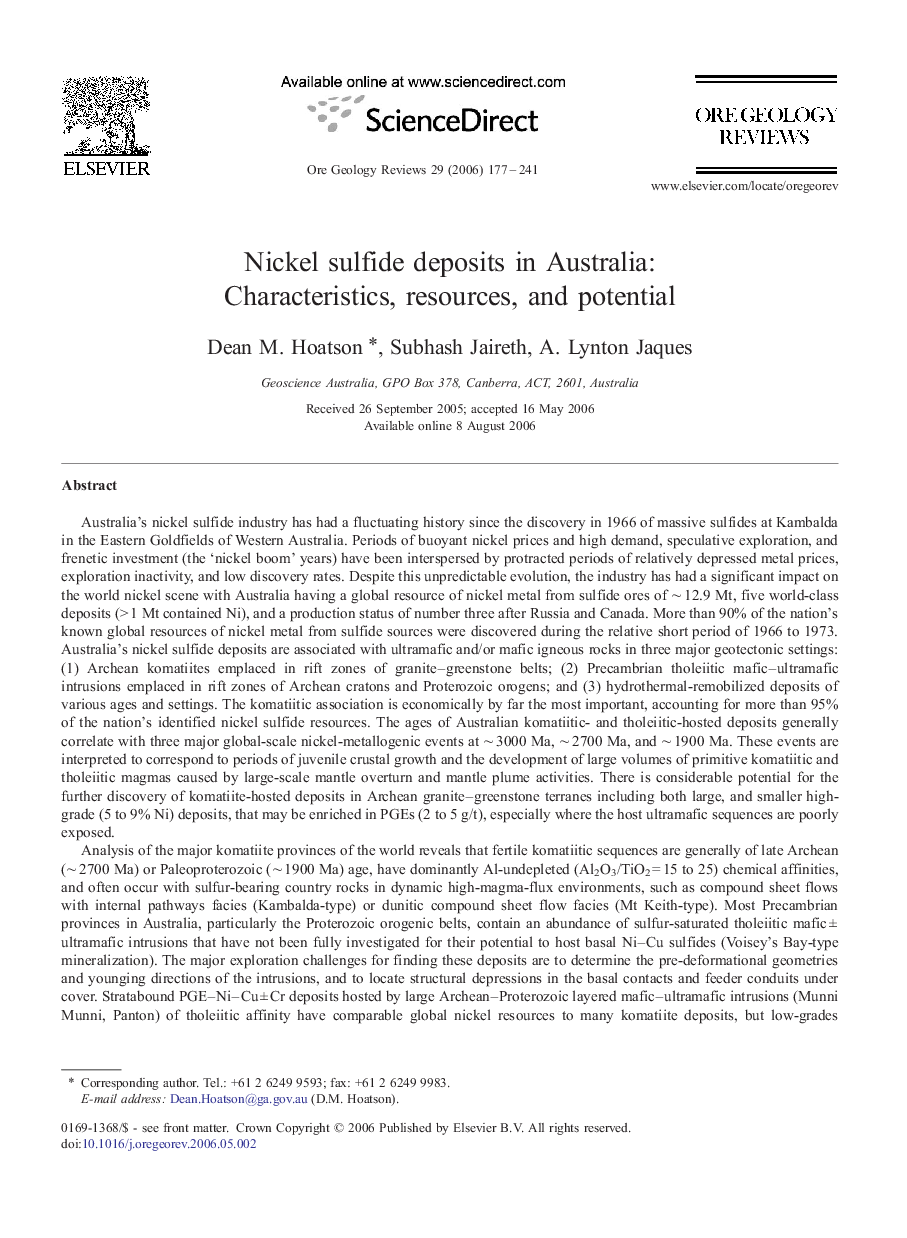| کد مقاله | کد نشریه | سال انتشار | مقاله انگلیسی | نسخه تمام متن |
|---|---|---|---|---|
| 4698045 | 1637272 | 2006 | 65 صفحه PDF | دانلود رایگان |

Australia's nickel sulfide industry has had a fluctuating history since the discovery in 1966 of massive sulfides at Kambalda in the Eastern Goldfields of Western Australia. Periods of buoyant nickel prices and high demand, speculative exploration, and frenetic investment (the ‘nickel boom’ years) have been interspersed by protracted periods of relatively depressed metal prices, exploration inactivity, and low discovery rates. Despite this unpredictable evolution, the industry has had a significant impact on the world nickel scene with Australia having a global resource of nickel metal from sulfide ores of ∼ 12.9 Mt, five world-class deposits (> 1 Mt contained Ni), and a production status of number three after Russia and Canada. More than 90% of the nation's known global resources of nickel metal from sulfide sources were discovered during the relative short period of 1966 to 1973. Australia's nickel sulfide deposits are associated with ultramafic and/or mafic igneous rocks in three major geotectonic settings: (1) Archean komatiites emplaced in rift zones of granite–greenstone belts; (2) Precambrian tholeiitic mafic–ultramafic intrusions emplaced in rift zones of Archean cratons and Proterozoic orogens; and (3) hydrothermal-remobilized deposits of various ages and settings. The komatiitic association is economically by far the most important, accounting for more than 95% of the nation's identified nickel sulfide resources. The ages of Australian komatiitic- and tholeiitic-hosted deposits generally correlate with three major global-scale nickel-metallogenic events at ∼ 3000 Ma, ∼ 2700 Ma, and ∼ 1900 Ma. These events are interpreted to correspond to periods of juvenile crustal growth and the development of large volumes of primitive komatiitic and tholeiitic magmas caused by large-scale mantle overturn and mantle plume activities. There is considerable potential for the further discovery of komatiite-hosted deposits in Archean granite–greenstone terranes including both large, and smaller high-grade (5 to 9% Ni) deposits, that may be enriched in PGEs (2 to 5 g/t), especially where the host ultramafic sequences are poorly exposed.Analysis of the major komatiite provinces of the world reveals that fertile komatiitic sequences are generally of late Archean (∼ 2700 Ma) or Paleoproterozoic (∼ 1900 Ma) age, have dominantly Al-undepleted (Al2O3/TiO2 = 15 to 25) chemical affinities, and often occur with sulfur-bearing country rocks in dynamic high-magma-flux environments, such as compound sheet flows with internal pathways facies (Kambalda-type) or dunitic compound sheet flow facies (Mt Keith-type). Most Precambrian provinces in Australia, particularly the Proterozoic orogenic belts, contain an abundance of sulfur-saturated tholeiitic mafic ± ultramafic intrusions that have not been fully investigated for their potential to host basal Ni–Cu sulfides (Voisey's Bay-type mineralization). The major exploration challenges for finding these deposits are to determine the pre-deformational geometries and younging directions of the intrusions, and to locate structural depressions in the basal contacts and feeder conduits under cover. Stratabound PGE–Ni–Cu ± Cr deposits hosted by large Archean–Proterozoic layered mafic–ultramafic intrusions (Munni Munni, Panton) of tholeiitic affinity have comparable global nickel resources to many komatiite deposits, but low-grades (< 0.2% Ni). There are also hydrothermal nickel sulfide deposits, including the unusual Avebury deposit in western Tasmania, and some potential for ‘Noril'sk-type’ Ni–Cu–PGE deposits associated with major flood basaltic provinces in western and northern Australia.
Journal: Ore Geology Reviews - Volume 29, Issues 3–4, November 2006, Pages 177–241